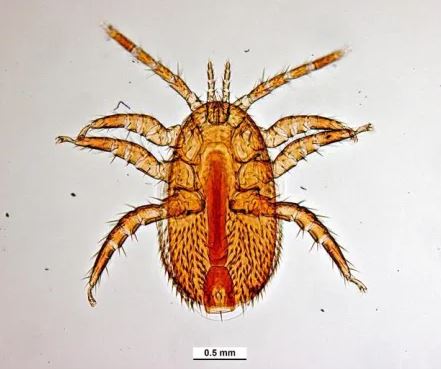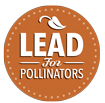By Wendy Mather, Program Manager, California Master Beekeeper Program
I did not anticipate nor was I prepared for the COVID 19 pandemic when the state of California shut down March 18, 2020. I did not expect school, business and retail closures, the hygiene protocols, the social distancing and the ‘stay-at-home’ orders. I felt ill-prepared as I hadn’t lived through a pandemic before. One of the saving graces for me during the peak of the pandemic was the peacefulness of my apiary…and I got to thinking…How prepared am I for the next invasive honey bee parasite, Tropilaelaps?
The What:
 A parasite, Tropilaelaps is closely related to and rivals Varroa destructor. Tropilaelaps is yet another ectoparasitic mite that has a significant negative effect on an Apis mellifera honey bee colony because it feeds on the brood.
A parasite, Tropilaelaps is closely related to and rivals Varroa destructor. Tropilaelaps is yet another ectoparasitic mite that has a significant negative effect on an Apis mellifera honey bee colony because it feeds on the brood.
Originally, these mites were parasites of Giant honey bees like Apis dorsata. Tropilaelaps are small, so these mites in the brood of a Giant honey bee colony have a more balanced host-parasite relationship. Adult Tropilaelaps mites are a third of the size of Varroa.
Like Varroa, Tropilaelaps feeds on developing brood, and the foundresses tear feeding holes in the larvae for their young. They reach maturity in a week! Their chelicerae aren’t powerful enough to perforate the exoskeleton of Apis mellifera, so these mites can only survive on adult bees for 24-36 hours before they starve to death.
Doing an alcohol wash or sugar shake wouldn’t give a beekeeper an accurate count as >95% of these mites are under the cap. Drone uncapping and sticky boards can offer an assessment of infestation. And, like Varroa, Tropilaelaps can be easily spread through drift and beekeeping management practices.
I have concerns that two species of Tropilaelaps have already jumped from the Giant honey bee to Apis mellifera, that there can be 25:1 ratio of Tropilaelaps to Varroa in a hive, and that between 3 or 4 gravid female Tropilaelaps will emerge with each nurse bee and enter another brood cell.
The Why:
Why should we be concerned now? Like Varroa, Tropilaelaps started in South East Asia, and, according to Dr. Sam Ramsey, its distribution is expanding at an alarming rate, following the same trajectory as Varroa did! As he reports, it only takes one mite, as they are already pregnant when they emerge from the cell.
We’re mitigating for Varroa here in North America as best we can. Imagine adding another parasite to the mix that also (and only) feeds on brood? Current research on enhancing hygienic behavior in honey bees is focused on Varroa. What happens if (and when) Tropilaelaps arrives?
In my pre-pandemic mindset, what I didn’t know about COVID-19, I couldn’t stress about. I’ve taken the same approach with Tropilaelaps. These mites are on the other side of the planet. We do not import bees from that area, so there’s no need for concern. Well, I was wrong! In 2021, humanity shares a global ecosystem and international travel may speed the arrival of our beloved honey bee’s next parasite. As Dr. Ramsey says “know your enemy”, don’t wait until Tropilaelaps is here as it will be too late.
The When:
Apparently, beekeepers don’t need to be concerned about the arrival of Tropilaelaps in the US because the mites don’t travel well. They need brood in order to survive. It’s noteworthy that within 15 years of Varroa arriving in the Middle East, beekeepers’ hives in the US were beginning to crash as a result of Varroa infestations.
Tropilaelaps clareae is present across Asia, while Tropilaelaps mercedesae is present throughout regions of mainland Asia and Indonesia. Both species are now in Papua New Guinea. It’s a question on the minds of concerned beekeepers and researchers as to when the US can expect this uninvited guest. Perhaps in the next ten or twenty years? Maybe never Maybe soon? What I do know is a significant portion of our agriculture relies on honey bee pollination. “Honey bees contribute nearly $20 billion to the value of U.S. crop production. This contribution, made by managed honey bees, comes in the form of increased yields and superior quality crops for growers and American consumers. A healthy beekeeping industry is invaluable to a healthy U.S. agricultural economy.” (https://www.abfnet.org/page/PollinatorFacts)
The How:
What can we do to mitigate for these pests in the sad event of their arrival her in the US? The phrase that I keep hearing is “know your enemy”. I’ve been reading up on this infamous relative of Varroa destructor and I’ve come to these conclusions:
- Expand and include Tropilaelaps in our current research efforts on fighting the mites of the Western and European honey bees in general
- Examine and rigorously test the best mite mitigation methods available to beekeepers prior to the arrival of Tropilaelaps, and have a proven IPM plan ready
Conclusion:
Tropilaelaps is an emerging threat to honey bee health and beekeeping. Know your beekeeping goals, do your research and have a plan in place. Read, watch and listen to the science on Tropilaelaps. Understand its’ life cycle, why it parasitizes honey bees, when we can expect it, and how to mitigate for it before it arrives.
Sounds like another regular day in the apiary to me.
LEARN MORE about guest blog writer, Wendy Mather and the California Master Beekeeper Program HERE
(photo of Tropliaelaps mite from Entomology Today )
